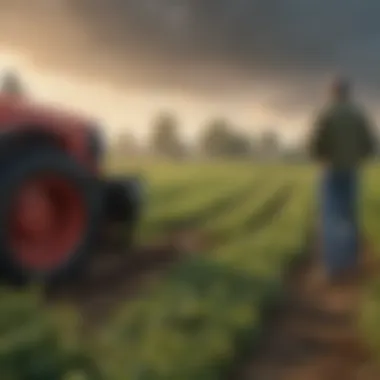Top Post-Emergence Herbicides for Crop Management


Intro
As agriculture faces growing challenges, including climate change and the increasing demand for food production, the role of post-emergence herbicides becomes more crucial. These herbicides are applied after crops have emerged, targeting weeds that compete for resources. Understanding their modes of action, effectiveness, and best practices is vital for farmers who want to manage weeds effectively while ensuring crop health and yield.
This article provides a focused examination on post-emergence herbicides, covering key aspects such as efficacy, application methods, and selection criteria. Through careful analysis, it aims to equip farmers and agricultural professionals with the necessary knowledge to make informed decisions. By adopting effective weed management strategies, farmers can not only enhance productivity but also adhere to sustainable farming practices.
Understanding Post-Emergence Herbicides
Post-emergence herbicides play a crucial role in effective weed management strategies within agriculture. Recognizing their significance is essential for farmers who seek to maximize crop yield and maintain agricultural health. These herbicides target weeds after they have emerged from the soil. This action allows farmers to manage existing weed populations without harming the crop itself, which is often not possible with pre-emergence herbicides.
Farmers must understand the specific functions and importance of post-emergence herbicides. Understanding these factors aides in selecting the appropriate products for their unique agricultural needs. It also contributes to sustainable farming practices, which aim to balance effective weed control with environmental considerations.
Definition and Function
Post-emergence herbicides are chemicals applied to crops after the crop and weeds have emerged above the surface. The primary function of these herbicides is to control or kill weeds that compete with crops for nutrients and light. They are formulated to target specific weed species and can be absorbed through leaves or roots, depending on their type. For instance, some herbicides may disrupt photosynthesis in targeted weeds, leading to their eventual death.
Different post-emergence herbicides have unique properties and must be applied at specific growth stages of weeds to ensure maximum effectiveness. This requires knowledge about both the weeds present in the fields and the crops being grown.
Importance in Weed Management
The significance of post-emergence herbicides in weed management cannot be overstated. They help in controlling established weeds, which is often a major challenge for farmers. Weeds can severely reduce crop yields by competing for essential resources. Therefore, effective use of post-emergence herbicides can lead to increased agricultural productivity.
Aside from controlling existing weeds, these herbicides also play a vital role in integrated weed management strategies. They can complement other methods, such as crop rotation and mechanical weeding, contributing to a holistic approach to weed suppression.
Furthermore, timely application of post-emergence herbicides can prevent weeds from seeding, thus reducing future weed pressure. This makes them a key component in any effective crop management strategy.
"Effective weed management is fundamental to maximizing yields and ensuring crop health."
Types of Post-Emergence Herbicides
Understanding the different types of post-emergence herbicides is essential for effective weed management in agriculture. Each category serves distinct purposes and offers various benefits. These herbicides help ensure that crop yields remain high by targeting unwanted vegetation without harming the crops. This understanding can guide farmers in making informed decisions that align with their specific agricultural practices and weed management goals.
Selective Herbicides
Selective herbicides are designed to target specific weed species while leaving the desired crops unharmed. This selectivity is achieved through variations in the way these herbicides interact with different plant species. For instance, selective herbicides often exploit metabolic pathways unique to certain weeds, allowing for effective control without damaging broadleaf or cereal crops.
Farmers find this type advantageous as it minimizes the risk of crop injury during application. Popular products in this category include 2,4-D and atrazine, which work effectively against weeds like dandelions and crabgrass. The use of such herbicides is a vital strategy in integrated weed management, reducing competition for nutrients, water, and light, which ultimately promotes healthier crop development.
"By using selective herbicides, farmers can significantly reduce the number of competitive weeds, helping to increase overall productivity."
However, it is critical to apply them at the correct growth stages. Applying too early or too late can mitigate their effectiveness and may lead to unexpected crop damage.
Non-Selective Herbicides
In contrast, non-selective herbicides target a broad spectrum of plant species. These products are often applied to areas where farmers do not desire any plant life, such as driveways or prior to planting new crops. Glyphosate is a commonly known non-selective herbicide that kills nearly all actively growing plants it contacts.
Non-selective herbicides can be very effective for managing perennial weeds that have extensive root systems. However, careful management is required because they can also harm desirable crops if not applied correctly. Farmers often use non-selective herbicides in combination with other methods to manage tough weed populations, leading to successful results when done judiciously.
Contact vs. Systemic Herbicides
Understanding the difference between contact and systemic herbicides is key for effective application.
Contact herbicides damage or kill plants upon direct contact. This category can quickly control weeds, but their effectiveness is often limited to the plant parts that receive the spray. An example is paraquat, which is widely recognized for its rapid action on exposed foliage.
On the other hand, systemic herbicides are absorbed by the plant and translocated throughout its system. This allows them to target root systems effectively, making them suitable for deeper-rooted weeds. Glyphosate also falls into this category, ensuring that even the most stubborn weeds undergo effective control once absorbed.


The choice between contact and systemic products should be guided by the weed species present, their growth habits, and the specific goals of the application. By understanding these different types, farmers can optimize their weed management strategies, tailoring their approach to the unique conditions of their fields.
Mechanisms of Action
Understanding the mechanisms of action of post-emergence herbicides is crucial for anyone involved in agriculture. The way these herbicides affect weeds directly influences their effectiveness and the overall success of crop management strategies. When farmers know how a herbicide works, they can make better choices about which products to use and how to apply them.
Mode of Action Overview
The mode of action of post-emergence herbicides refers to the specific biochemical process through which these chemicals inhibit or disrupt the normal physiological functions of target weeds. Different herbicides use various pathways to exert their effects, and understanding these pathways helps in selecting the right herbicide for specific weed problems.
Common modes of action include:
- Inhibition of photosynthesis: Certain herbicides, like atrazine, block the photosynthetic process, leading to the death of plants that rely on sunlight.
- Disruption of amino acid synthesis: Herbicides like glyphosate inhibit the enzyme pathways necessary for amino acid production, starving the plant of essential nutrients.
- Cell division interference: Some herbicides target the process of cell division, preventing growth and eventual death of the weed.
By comprehending these actions, farmers can anticipate how weeds will respond and adjust strategies accordingly. Moreover, integrating multiple modes of action can help prevent weed resistance, ensuring the long-term viability of herbicide effectiveness.
Factors Influencing Efficacy
The efficacy of post-emergence herbicides is influenced by several critical factors. This understanding is essential when planning herbicide applications, as ineffective use can lead to poor weed control and economic losses. Key factors include:
- Environmental Conditions: Weather plays a significant role. High temperatures and humidity can enhance the absorption of herbicides by the target plant. On the other hand, rain shortly after application may wash away the chemical before it can work effectively.
- Weed Growth Stage: Herbicides usually work best when the target weeds are at a specific growth stage. For example, younger, actively growing weeds are generally more vulnerable than mature ones.
- Application Method: The method used to apply the herbicide affects its efficacy. For instance, spray application techniques may vary, leading to differences in coverage and penetration of the herbicide.
- Soil Type and Conditions: The characteristics of the soil, such as pH and organic matter content, can influence the persistence and activity of some herbicides.
Criteria for Selecting Post-Emergence Herbicides
Selecting the right post-emergence herbicide is essential for effective weed management. This section will focus on critical factors that influence this selection, providing farmers and agricultural professionals with a structured approach to make informed decisions. The correct herbicide can improve crop yield and protect against weed competition, while poor selection can lead to ineffectiveness and potential crop damage.
Target Weed Species
Understanding target weed species is fundamental. Different herbicides have varying spectra of activity. For instance, glyphosate is effective against a wide range of annual and perennial weeds. In contrast, products like 2,4-D are more suited for broadleaf weed control. Identifying the specific weeds present in a field can aid in selecting the appropriate herbicide that will maximize efficacy.
Lastly, proper identification minimizes the risk of developing herbicide-resistant weed populations. This informs the management strategy, emphasizing the importance of rotating herbicide classes to mitigate resistance development.
Crop Compatibility
Crop compatibility is another vital consideration. Not all herbicides can be safely applied to every crop. For example, atrazine is widely used in corn, but can cause harm to sensitive crops like soybeans if not applied carefully. Always refer to the herbicide label for crop tolerance information before application. This not only prevents crop injury but also maximizes the potential for successful weed control.
Furthermore, certain herbicides are formulated to be selective, meaning they will not harm the crops while targeting weeds. Understanding these compatibility dynamics is key to optimizing crop health and yield.
Environmental Considerations
Finally, environmental considerations play a crucial role in selecting post-emergence herbicides. Factors such as soil type, weather conditions, and surrounding ecosystems can impact herbicide performance and behavior.
For example, applying herbicides during windy conditions can lead to drift, affecting non-target areas and potentially causing ecosystem disruption. Similarly, the potential leaching of herbicides into water sources must be assessed to comply with environmental regulations. Farmers should always prioritize sustainability by choosing herbicides that minimize ecological impact, which also aligns with responsible agricultural practices.
"Choosing the right herbicide is not merely about effectiveness against weeds; it also involves understanding its impact on crop health and the surrounding environment," emphasizes agricultural specialists in this field.
Application Techniques
Application techniques for post-emergence herbicides play a significant role in ensuring the effectiveness and safety of weed management practices. Understanding the nuances involved in applying these herbicides can lead to better weed control, higher yields, and enhanced sustainability.
Timing of Application
The timing of application is crucial in maximizing the efficiency of post-emergence herbicides. Applying herbicides too early or too late can result in inadequate weed control, leading to economic losses. Optimal timing usually depends on the growth stage of both the crop and the target weeds. For instance, it is often best to apply herbicides when weeds are actively growing and in the correct growth stage, typically before they reach maturity. This can vary based on the type of weed being targeted. Understanding the specific life cycle of weeds can help farmers time their applications effectively.


Application Equipment
Using the right application equipment can influence the distribution and efficacy of herbicides. Farmers must consider the type of sprayer they use, whether it’s a backpack sprayer, tractor-mounted sprayer, or drone technology. Each method has its own advantages; for example, drone application can cover large areas quickly and can reach difficult terrains. Proper calibration of the equipment is also vital. An improperly calibrated sprayer can lead to overdosing or underdosing, both of which carry risks. Regular maintenance and cleaning of application equipment are essential to ensure optimal performance during herbicide application.
Application Rates
Determining the correct application rates is crucial for achieving desired weed control while minimizing crop injury and environmental risks. The label of the herbicide should always be followed closely, as it details recommended rates specific to the weed species and crop. Factors that could affect application rates include environmental conditions, soil type, and the specific herbicide formulation. Farmers should also consider mixing rates if combining multiple herbicides, as incorrect ratios can lead to diminished effectiveness or harmful synergies. Educating oneself about various formulations can aid in selecting the right one for particular field conditions.
Effective weed management requires careful planning and execution, especially when it comes to application techniques. Farmers are encouraged to keep detailed records of application timing, equipment used, and rates applied for improved decision-making in future seasons.
Potential Risks and Considerations
The use of post-emergence herbicides brings various benefits in crop management. However, it is crucial to acknowledge the potential risks and considerations associated with their application. These risks can have substantial implications for crop yield, sustainability, and the overall health of ecosystems. Understanding these factors is essential for making informed decisions when selecting and using herbicides.
Crop Injury
Crop injury is a significant concern when applying post-emergence herbicides. Misapplication or improper use can lead to phytotoxicity, which affects crop growth and yield. Factors influencing crop injury include the herbicide's formulation, application rate, and timing relative to the crop's growth stage. For instance, certain herbicides may cause foliage burn or other symptoms when applied during sensitive growth phases.
Best practices to minimize crop injury include:
- Adhering to Label Instructions: Always follow the guidelines provided on the product label.
- Timing Applications: Apply herbicides at the recommended growth stages of both the target weeds and the crops.
- Spot Testing: Test herbicide on a small area before widespread application, especially if using a new product.
Herbicide Resistance
Herbicide resistance poses a significant challenge in weed management. Continuous use of the same herbicide or those with similar modes of action can lead to the selection of resistant weed populations. This resistance reduces the effectiveness of control measures, leading to increased herbicide applications and costs for farmers.
To mitigate the risk of resistance, consider these strategies:
- Rotate Herbicides: Use different modes of action in successive applications.
- Utilize Integrated Weed Management: Combine chemical controls with cultural and mechanical strategies, such as crop rotation and manual weeding.
- Monitor Weed Populations: Regularly assess the fields for weed types and resistance levels to adjust management practices accordingly.
Environmental Impact
The environmental impact of post-emergence herbicides cannot be overlooked. Several factors influence how these chemicals interact with soil, water, and non-target organisms. Runoff from treated fields can contaminate waterways, affecting aquatic ecosystems. Additionally, volatile organic compounds from certain herbicides can contribute to air pollution.
To lessen potential environmental harm, consider the following:
- Buffer Zones: Establish buffer zones around sensitive areas such as waterways.
- Choose Environmentally Friendly Options: Explore herbicides with lower toxicity to non-target species and less potential for runoff.
- Educate on Proper Use: Ensure that all farm personnel understand the correct methods for applying herbicides to minimize waste and environmental exposure.
Understanding the potential risks and considerations surrounding post-emergence herbicides is crucial for sustainable agriculture. Implementing effective strategies can enhance crop management while protecting our ecosystems.
Emerging Trends in Herbicide Development
The agricultural landscape is changing, and with it, the approaches to weed management. Emerging trends in herbicide development are crucial for addressing modern challenges in crop management. These trends focus on sustainability, efficiency, and the growing need for environmentally friendly practices. The shift towards biopesticides and precision agriculture shows a commitment to reducing chemical dependencies while maintaining or enhancing crop yields. This section will delve into notable developments reshaping how farmers tackle weed problems.
Biopesticides and Natural Alternatives
Biopesticides are gaining attention for their potential to offer effective weed management solutions without the harsh impacts associated with traditional chemicals. They derive from natural materials, including plants, bacteria, and minerals. The benefits of using biopesticides are numerous:
- Reduced Environmental Impact: They are less likely to contribute to pollution and can integrate well into organic farming systems.
- Targeted Action: Many biopesticides can target specific pests or weeds without harming non-target species.
- Resistance Management: With herbicide resistance on the rise, biopesticides provide an alternative means of control, potentially prolonging the effectiveness of conventional herbicides.
Research is ongoing to identify more biopesticides and understand their optimal application techniques. The evolution of natural alternatives encourages a shift in the mindset of farmers towards integrated pest management systems that prioritize ecological balance.
"Embracing biopesticides could revolutionize how we think about pest and weed management in agriculture, fostering a more sustainable future."


Precision Agriculture Application
Precision agriculture employs advanced technologies to optimize field-level management regarding crop production. The concept is built on the idea of treating variability in the field, allowing farmers to apply the right amount of herbicides at the right time. This trend offers several advantages:
- Data-Driven Decisions: Farmers can utilize data analytics to monitor weed pressure and soil health, helping to determine the most effective herbicide applications.
- Resource Efficiency: By minimizing wastage, precision application techniques save costs while being kinder to the environment.
- Enhanced Efficacy: Accurate targeting of herbicides can lead to better control of weed populations, reducing the likelihood of crop competition.
As technology continues to advance, integrating drones, sensors, and GPS capabilities into herbicide application processes is expected to become more common. Understanding how to properly leverage these tools can offer significant benefits for farmers aiming to maintain crop productivity while adhering to sustainable practices.
Regulatory Considerations
Regulatory considerations play a pivotal role in the agricultural landscape, particularly in the use of post-emergence herbicides. Farmers must understand the legal framework that governs these products to ensure compliance and efficacy. Recognition of these regulations can significantly enhance sustainable farming practices and consumer trust. Furthermore, effective regulation is vital in mitigating potential negative impacts on both the environment and human health.
Label Compliance
Label compliance is a fundamental aspect of using post-emergence herbicides. Each herbicide comes with a label detailing its application rates, timing, and safety precautions. Following these guidelines is essential to maintain crop safety and effectiveness. Not adhering to label instructions can result in unintended consequences such as crop injury, reduced yields, or the development of herbicide-resistant weed species.
Farmers should ensure they are familiar with the following elements of label compliance:
- Application Guidelines: Understanding the correct timing and method of application to maximize herbicide effectiveness.
- Safety Precautions: Recognizing necessary protective measures that must be taken during application to safeguard health and the environment.
- Resistance Management: Implementing practices that decrease the chance of developing herbicide-resistant weed populations, as directed by the label.
In essence, adhering to the label ultimately aids in achieving the best results while promoting responsible herbicide use in agriculture.
Environmental Regulations
Environmental regulations surrounding post-emergence herbicides are designed to safeguard ecosystems and water quality. These regulations aim to restrict the use of certain chemicals that may pose risks to non-target organisms, runoff, and long-term soil health.
Farmers must be aware of several key considerations regarding environmental regulations:
- Protecting Water Sources: Many regulations include buffer zones around water bodies to prevent contamination from herbicide runoff.
- Wildlife Protection: Certain herbicides may threaten local wildlife. Using alternatives or following specific guidelines helps minimize this risk.
- Soil Health: Applications that harm beneficial soil microorganisms may lead to long-term issues. Understanding the impact of selected herbicides on soil health is crucial.
Effective navigation of these regulations ensures that agricultural practices not only comply with legal standards but also contribute to the sustainability of farming operations.
"By integrating regulatory considerations into herbicide management strategies, farmers promote not just compliance but also stewardship of the environment."
Understanding both label compliance and environmental regulations is essential for successful post-emergence herbicide use. These regulations can guide farmers in making informed decisions that align with broader agricultural goals.
Best Practices for Effective Use
Adopting best practices in the application of post-emergence herbicides is crucial for achieving optimal crop management. These practices not only enhance the effectiveness of weed control but also safeguard crop health, reduce the potential for resistance development, and minimize environmental impacts. Understanding the elements that comprise effective herbicide use helps farmers make informed decisions that can lead to increased productivity and sustainable farming.
Integrated Weed Management Strategies
Integrated Weed Management, or IWM, is a holistic approach to controlling weed populations in agricultural settings. Combining multiple strategies can lead to more effective and sustainable outcomes. The key components of IWM include:
- Cultural Practices: These involve adjusting planting dates, crop rotation, and modifying row spacing to outcompete weed species. These practices can lower weed pressure without solely relying on herbicides.
- Mechanical Control: This includes methods like tillage and mowing to physically disrupt weed growth. Incorporating mechanical methods reduces the reliance on chemical solutions and can be a part of an effective strategy.
- Chemical Control: Selecting the right post-emergence herbicides based on target weed species, application timing, and environmental factors enhances efficacy. Using a mix of selective and non-selective herbicides can also help in combating diverse weed populations.
- Monitoring and Assessment: Regularly observing weed populations and their responses to control methods is vital. This can help in fine-tuning management strategies and tailoring interventions to specific challenges.
Incorporating these components into regular farming practices can significantly reduce weed populations and their impact on crop yields. Optimal use of integrated weed management strategies aligns with sustainable farming principles and supports responsible agricultural stewardship.
Education and Training
Education and training are fundamental to ensuring the effective use of post-emergence herbicides. Farmers and agricultural professionals must stay informed about best practices, safety protocols, and the latest developments in herbicide technology. Key areas of focus include:
- Understanding Herbicide Labels: Knowledge of labels is essential. Labels provide information on application rates, timing, and safety measures that should be followed. Misinterpretations can lead to ineffective application or crop injury.
- Workshops and Seminars: Participating in local agricultural meetings, workshops, and extension services can enhance understanding of current trends in herbicide use and management strategies. Learning from experts can bring fresh insights.
- Peer Learning: Engaging with fellow farmers can lead to shared experiences and collaborative problem-solving regarding weed management challenges.
- Regular Training on Equipment Use: Training on application equipment ensures that farmers can use tools effectively and safely, minimizing risks to crops and the environment.
Training and education not only improve the immediate effectiveness of herbicide application but also foster a culture of continuous learning. Emphasizing education within the agricultural community contributes to a more knowledgeable base of professionals equipped to tackle ever-evolving weed management challenges.
"Effective herbicide use and management starts with knowledge and training. This empowers farmers to make informed decisions while minimizing risks."
By integrating both IWM strategies and robust education initiatives, the path to effective post-emergence herbicide application becomes clearer. This not only leads to healthier crops but also supports sustainable agricultural practices.



